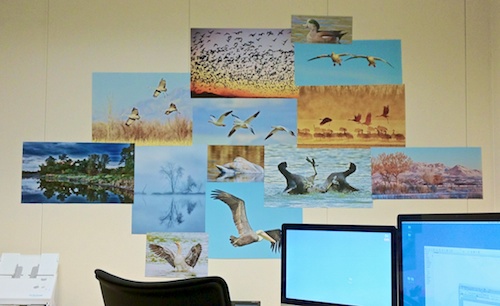
Well, it isn't - or at least it shouldn't be. The ability to store and view your images on an iPad or share via the web is awesome, but it doesn't have to replace the printed art form - it should compliment it. It may take a few minutes of time and some money (although it doesn't have to be expensive) but to see and share your work in large format and bright color is fantastic - and will be a constant source of satisfaction and pride.
Here are a couple ideas to display your craft and have fun doing it - without spending an arm and a leg. It doesn't have to cost you upwards of $60 to $150 per framed print, just be a little creative!
- Homemade Craft(my wife's great idea)
- Take a Sunday drive into the country and keep your eye out for antique and yard sales - find a piece of scrap barn wood or some other type of weathered wood. The piece of barn wood below cost $20.
- Pick three or four images that go together or tell a similar story. Print them out in 8x10 format (on regular 8.5x11 photo paper) Cost of ink and paper is at most a couple dollars.
- Clear, frameless clip frames. We got the ones below from Hobby Lobby or you can get them from Amazon for around $5 each.
- The sample below cost less than $38 dollars and looks great in the family room!
- Frameless clusters
- Build a wall collage of images on 13x19 paper (or 8.5 by 11 if that's all you have available). You can be creative with your crops and just trim the excess - it really enhances the collage.
- Now - this is cheap, creative and fun way to display your image art. (though I admit might not be for everyone's taste) The image below and the one at the beginning of this post are collages I put up in my office. And I'm not done - I'm planning for the larger one to take up the whole wall!
- The Epson Matter 13x19 paper worked out astonishing well (and very cost effective) so you don't need to use the more expensive photo paper.
- Each 13x19 image cost me less than 50 cents each (printing myself) so the total large collage was a whopping $6! (and if I don't like it or want to start over, it's no big deal)
Have fun, get a little creative and hang some of your work for all to see. I love the satisfaction and enjoyment I feel every time I look up from my desk and see some of my favorite images - give it a try!!
See the light!
Mark




















 I recently grabbed my camera and my wife one evening to catch a great sunset, only to find out I didn't bring the requisite memory card with me (yea, rookie mistake). So what to do now?
I recently grabbed my camera and my wife one evening to catch a great sunset, only to find out I didn't bring the requisite memory card with me (yea, rookie mistake). So what to do now?